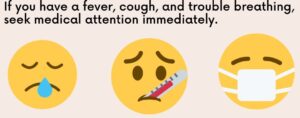What is a fever and when should you see a doctor?
Humans, like all mammals, are warm-blooded, which means that even when the temperature of our surroundings changes, our bodies maintain a relatively constant temperature.
Our bodies tend to maintain a temperature between 97 and 99 degrees Fahrenheit for the majority of people. In certain situations, however, our body temperature elevates, causing a fever.
According to Dr. Brian, your body’s immune system generates a fever to fight infection. As a specialist in internal medicine and pediatrics, Dr. Brian treats children and adults of all ages for a variety of ailments.
Fever of low severity
Generally speaking, a fever is defined as a body temperature above 100.4 degrees Fahrenheit. Typically, a body temperature between 100.4 and 102.2 degrees is regarded as a low-grade fever.
“Medication is not required if the temperature is not high,” Dr. Brian explained.
A low-grade fever usually doesn’t require treatment, unless the fever is occurring in a very young neonate, or if it’s accompanied by other alarming symptoms, such as confusion or the inability to consume or drink without purging.
Dr. Brian suggests bathing in tepid or chilly water or donning minimal garments to reduce a fever without medication. Additionally, you should consume plenty of fluids to maintain hydration.
Also, bear in mind that even a moderate fever may indicate an infectious disease. Handwashing and concealing your wheeze are always recommended practices.
“In the age of COVID-19, people should keep in mind that if they have a fever that persists, they should probably get tested,” Dr. Brian said.
Not positive if you need a test or where to obtain one? Use Clare, our digital assistant, located in the lower right corner of the OSF HealthCare website.
a feverish condition
When the body’s temperature rises above 102.2 degrees, a more severe infection may be present.
Get treatment for common ailments
Locate emergent care
Dr. Brian explains that most fevers subside within a few days, but there are situations in which a visit to a primary care office or urgent care clinic is warranted.
Consider visiting a physician if:
- Fever persists beyond three to five days
- There is no response to fever-reducing medications, such as ibuprofen.
- Ibuprofen or acetaminophen (Tylenol or Advil)
- Additional symptoms include bewilderment, neck rigidity, and light sensitivity.
“Another reason to seek medical attention is if you don’t feel right about how things are going,” Dr. Brian explained.
Rarely could a fever indicate a medical emergency.
If you have a fever and any of the following symptoms, call 911 or go directly to the nearest emergency room.
- Paroxysmal Convulsions
- Throbbing abdominal discomfort
- urination causes pain or scorching
- chest discomfort or shortness of breath
- Problems with fluid retention
- Chronic migraine
Adult Fever’s Root Causes
Pyrogens are substances that result in hyperthermia. Pyrogens can originate from either the interior or exterior of an organism. Microorganisms and the substances they produce (such as toxins) are examples of exogenously produced pyrogens. Typically, monocytes and macrophages (two categories of white blood cells) are responsible for producing pyrogens within the body. External pyrogens can cause fever either by stimulating the body to produce its own pyrogens or by directly influencing the region of the brain that regulates body temperature.
Fever can be caused by factors besides infection. Fever may also be caused by inflammation, a drug reaction, an allergic reaction, autoimmune disorders (when the body generates abnormal antibodies that target its own tissues), and undetected cancer (notably leukemia, lymphoma, or renal cancer).
Multiple disorders can induce fever. In general, they are classified as
- Most prevalently infectious
- Neoplasticity (cancer)
- provoking inflammation
In adults with a fever lasting four days or less, an infectious cause is highly likely. A noninfectious cause is more likely to result in recurrent or persistent fevers.
Many malignancies result in fever.
Fever is caused by inflammatory disorders of the joints, connective tissues, and blood vessels, such as rheumatoid arthritis, systemic lupus erythematosus (lupus), and giant cell arteritis.
In addition, individuals with cancer or a known inflammatory disorder are more likely to have an infectious cause for a short-lived (acute) fever that occurs in isolation. In healthy individuals, a transient fever is unlikely to signal the onset of a chronic illness.
Occasionally, drugs induce fever. For instance, beta-lactam antibiotics (including penicillin) and sulfa drugs can cause a fever. Certain illegal substances (such as cocaine, amphetamines, or phencyclidine) as well as anesthetics and antipsychotics can produce an exceptionally elevated body temperature.
Commonest causes
Almost all infectious diseases can result in fever. In general, however, the most probable infectious causes are
- Upper and lower respiratory tract illnesses
- Infectious gastroenteritis
- Urinary tract infections (UTI)
- Infected skin
Viruses cause the vast majority of acute respiratory and gastrointestinal infections.
Risk elements
Certain conditions (risk factors) increase the likelihood that someone will develop a fever. Included among these elements are:
- The heath status of a person
- Age of the subject
- Several professions
- Use of particular medical procedures and medications
- Exposure to infections (such as via travel or contact with infected humans, animals, or insects)
Important Features
- Virus-caused respiratory or gastrointestinal infections induce the majority of fevers in healthy individuals.
- If individuals with a fever exhibit any warning signs, they should consult a physician immediately.
- In most cases, physicians can identify an infection based on a brief medical history, a physical examination, and occasionally a few simple tests. They then use these results, particularly symptoms, to determine which additional tests are necessary.
- Long-lasting fevers may be caused by underlying chronic diseases, particularly those that impair the immune system, according to doctors.
- In most cases, taking acetaminophen or a nonsteroidal anti-inflammatory drug (NSAID) reduces fever and improves a person’s condition, although treatment is not essential for the majority of patients.
- Infections are less likely to produce fever and other symptoms may be less apparent in the elderly.